The Quantum Sensors Market is estimated at USD 0.4 billion in 2025 and is forecast to reach USD 1.7 billion by 2035, representing a robust CAGR of 15.0%. A contribution analysis by technology highlights the role of different sensor types and underlying quantum mechanisms in driving this market expansion. Key technology segments include atom interferometry-based sensors, superconducting quantum interference devices (SQUIDs), nitrogen-vacancy (NV) center diamond sensors, and optomechanical sensors.
Atom interferometry sensors currently account for a significant portion of the market due to their precision in gravimetry, navigation, and geophysical applications. SQUID-based devices contribute notably to magnetic sensing in medical imaging and industrial monitoring, while NV center diamond sensors are emerging as high-value contributors because of their room-temperature operation and nanoscale spatial resolution. Optomechanical sensors, leveraging quantum light-matter interactions, are gradually increasing their share, particularly in advanced scientific and defense applications.
Over the forecast period, the contribution of atom interferometry and NV center sensors is expected to expand, collectively comprising more than 50% of the total market value by 2035. SQUID-based sensors will maintain steady growth, supported by enhancements in cryogenic efficiency and miniaturization. Optomechanical sensors, though smaller in share initially, will demonstrate accelerated growth as commercialization advances.
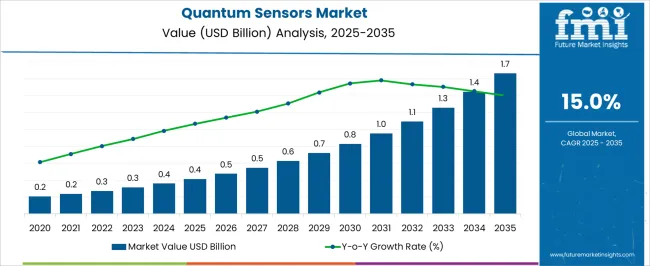
| Metric | Value |
|---|---|
| Quantum Sensors Market Estimated Value in (2025 E) | USD 0.4 billion |
| Quantum Sensors Market Forecast Value in (2035 F) | USD 1.7 billion |
| Forecast CAGR (2025 to 2035) | 15.0% |
The quantum sensors market is expanding steadily as advancements in quantum technologies unlock new capabilities in precision measurement and navigation. Research communities and industry players have highlighted the growing interest in quantum devices that offer unparalleled sensitivity and accuracy compared to classical sensors.
The increasing need for highly accurate timing, positioning, and detection in critical applications such as aerospace and defense is driving demand for quantum sensors. Innovation in platforms like neutral atoms has improved device stability and scalability, enabling broader adoption across complex systems.
Public and private investments in quantum research and development have further accelerated progress, fostering commercialization efforts. Additionally, the drive for enhanced security and advanced navigation in defense systems is supporting market growth. Moving forward, segmental growth is expected to be led by atomic clocks for their precision, neutral atom platforms for their robustness, and aerospace and defense as the leading end-use sector.
The quantum sensors market is segmented by type, platform, end use, application, and region. By type, it is divided into atomic clocks, magnetometers, gravimeters, gyroscopes, acoustic sensors, interferometers, and quantum imaging. By platform, it is classified into neutral atoms, photons, trapped ions, nuclear magnetic resonance, and optomechanics. By end use, the market is segmented into aerospace & defense, agriculture & environment, oil & gas, transportation, healthcare, automation, construction, and others. By application, it is categorized into precision measurement, environmental monitoring, medical imaging, and LiDAR. Regionally, the quantum sensors industry is divided into North America, Latin America, Western Europe, Eastern Europe, Balkan & Baltic Countries, Russia & Belarus, Central Asia, East Asia, South Asia & Pacific, and the Middle East & Africa.

The Atomic Clocks segment is forecasted to hold 33.2% of the quantum sensors market revenue in 2025, remaining the most prominent type. Their growth stems from their exceptional precision in time measurement, which is critical for synchronization in communication networks and navigation systems.
Atomic clocks are widely used in global positioning systems and defense applications where nanosecond accuracy is essential. The segment benefits from continuous technological refinements that improve clock stability and reduce size and power consumption.
The increasing demand for accurate timing in emerging applications such as 5G networks and satellite communications is expected to sustain the dominance of atomic clocks in quantum sensor technology.
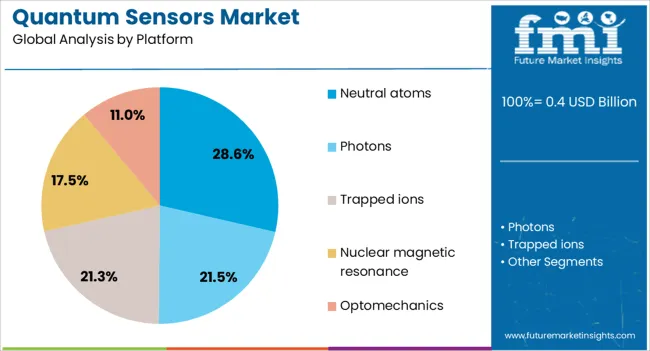
The Neutral Atoms platform segment is expected to contribute 28.6% of the market revenue in 2025, establishing itself as a leading quantum sensor platform. This platform is favored due to its ability to manipulate and control individual atoms with high precision, enabling highly sensitive measurements of magnetic and gravitational fields.
Advances in laser cooling and trapping techniques have enhanced the performance and scalability of neutral atom sensors. The platform’s robustness against environmental noise and suitability for integration into portable devices have increased its appeal in aerospace and defense applications.
As research into practical quantum sensor platforms advances, neutral atoms are anticipated to maintain strong growth.
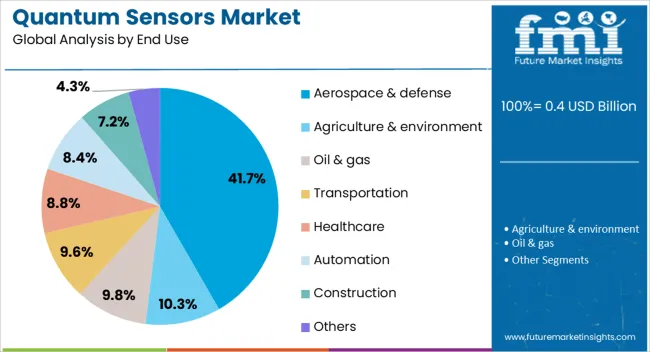
The Aerospace & Defense segment is projected to hold 41.7% of the quantum sensors market revenue in 2025, securing its position as the dominant end-use sector. This growth is fueled by the critical need for precise navigation, detection, and communication technologies within defense systems and aerospace vehicles.
Quantum sensors provide enhanced capabilities for inertial navigation in GPS-denied environments, threat detection, and secure communications. Governments and defense agencies are investing heavily in quantum technologies to maintain strategic advantages and improve mission success rates.
The sector's stringent requirements for reliability and accuracy align well with the unique strengths of quantum sensors. As aerospace and defense systems become more sophisticated, the demand for quantum sensor technology is expected to increase steadily.
The quantum sensors market has been expanding due to increasing demand for high-precision measurement solutions in defense, healthcare, aerospace, and industrial applications. Quantum sensors, leveraging principles of quantum mechanics, have been widely adopted for applications such as navigation, imaging, gravimetry, and magnetic field detection. Market growth has been supported by advancements in atomic, superconducting, and optical sensing technologies. Rising requirements for accurate, reliable, and non-invasive measurement solutions, coupled with technological innovations, have further strengthened the adoption of quantum sensors globally.
The growing need for ultra-accurate, high-sensitivity measurement systems has been a key driver of the quantum sensors market. These sensors are capable of detecting minute changes in magnetic fields, gravitational forces, acceleration, and other physical parameters with exceptional precision. Applications in aerospace navigation, defense targeting systems, medical imaging, and industrial monitoring rely on quantum sensors to achieve performance levels unattainable with classical sensors. Advancements in atomic interferometry, nitrogen-vacancy centers, and superconducting circuits have improved the sensitivity, stability, and reliability of measurements. Additionally, quantum sensors facilitate non-invasive and real-time monitoring, enhancing decision-making, operational efficiency, and safety across critical sectors. This growing demand for precision measurement solutions continues to fuel market expansion globally.
Technological innovations have significantly strengthened the performance, versatility, and scalability of quantum sensors. Atomic, optical, superconducting, and solid-state technologies have been integrated to achieve higher sensitivity, lower noise, and faster response times. Advances in cryogenic systems, laser stabilization, and quantum control techniques have enabled practical deployment in field and laboratory environments. The development of portable, compact, and energy-efficient quantum sensors has allowed adoption in defense, healthcare, and industrial sectors. Additionally, integration with AI, cloud analytics, and IoT platforms has improved data acquisition, interpretation, and predictive insights. These advancements have expanded applications, improved reliability, and facilitated commercialization, positioning quantum sensors as critical tools for precise and high-performance measurement in global markets.
Quantum sensors have found growing applications in defense, healthcare, and industrial monitoring, driving market adoption. In defense, they are used for navigation, submarine detection, and surveillance without reliance on GPS. Healthcare applications include high-resolution imaging, biomagnetic sensing, and non-invasive diagnostics. Industrial uses involve structural health monitoring, precision positioning, and process optimization. The ability to detect extremely small changes in environmental parameters allows for early fault detection, improved operational safety, and enhanced efficiency. Government agencies, defense contractors, hospitals, and industrial facilities have increasingly invested in quantum sensing technologies to achieve superior accuracy and reliability. The versatility of applications across multiple sectors has strengthened the market position of quantum sensors worldwide.
Expanding research activities, technological commercialization, and adoption in emerging markets have created significant growth opportunities for the quantum sensors market. Investments in quantum research by governments, private enterprises, and academic institutions have accelerated innovation in sensor design and applications. Emerging markets are witnessing increased adoption of advanced sensing technologies for defense modernization, industrial automation, and healthcare infrastructure development. The integration of quantum sensors with AI, data analytics, and cloud platforms offers additional opportunities for predictive monitoring, autonomous navigation, and enhanced measurement precision. As awareness and understanding of quantum technologies increase, the demand for practical, high-performance sensors is expected to rise globally, driving sustained growth and investment in the sector.
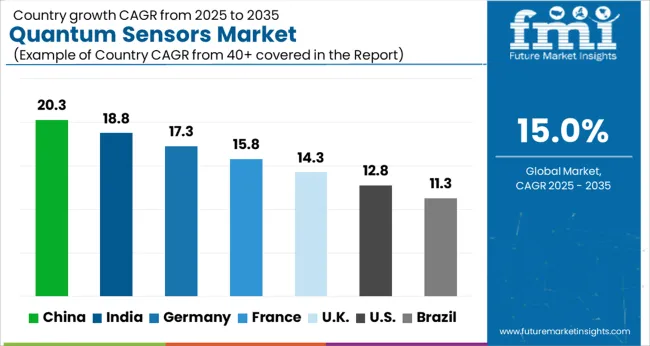
The market is anticipated to grow at a CAGR of 15.0% from 2025 to 2035, driven by increasing applications in defense, healthcare, navigation, and precision measurement technologies. China is projected to lead with a 20.3% CAGR, supported by significant government investments in quantum research and sensor technology commercialization. India follows at 18.8%, with growth fueled by expanding R&D initiatives and defense modernization programs. Germany, at 17.3%, benefits from strong industrial and scientific collaborations advancing quantum sensing solutions. The UK, growing at 14.3%, emphasizes innovation in navigation and biomedical applications, while the USA, at 12.8%, experiences steady expansion due to defense, aerospace, and commercial adoption of high-precision sensors. This report includes insights on 40+ countries; the top markets are shown here for reference.
Sales of quantum sensors in China are projected to expand at a CAGR of 20.3% from 2025 to 2035, fueled by advancements in precision measurement technologies and government-backed research programs. Investments in navigation, defense, and scientific applications are driving adoption, while domestic players are developing quantum accelerometers and magnetometers to meet industrial and military requirements. Strategic collaborations with global research institutions are enhancing innovation and production capabilities. High-tech manufacturing zones are focusing on integrating quantum sensing into industrial automation and satellite systems. The growing demand for ultra-accurate positioning and timing devices is reinforcing market growth.
The Indian quantum sensors industry is expected to grow at a CAGR of 18.8% between 2025 and 2035, driven by national initiatives in space, defense, and navigation sectors. Private and public laboratories are investing in high-precision atomic clocks and magnetometers. Collaborations with universities and global technology partners are facilitating technology transfer and prototype development. Industries such as autonomous transport, geophysics, and telecommunications are progressively integrating quantum sensors to enhance operational accuracy. Increasing governmental funding and policy support are fostering research adoption in commercial and industrial applications.
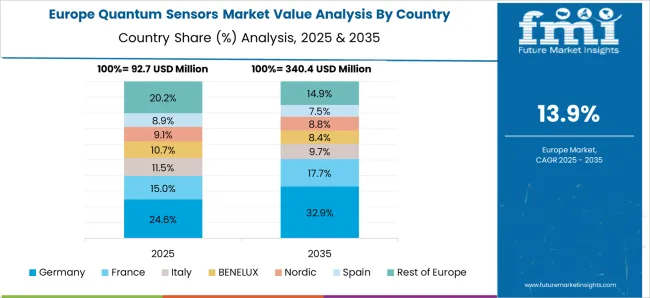
Germany is projected to witness a 17.3% CAGR in quantum sensor sales from 2025 to 2035, supported by the country’s advanced optics and photonics ecosystem. Strong academic and industrial collaborations are fostering next-generation sensor development. The automotive and aerospace industries are leveraging quantum inertial sensors for precise navigation and positioning. Investments in photonic integrated circuits and cryogenic technology are enhancing sensor performance. Government funding for research initiatives is accelerating commercialization of quantum-enabled devices.
Quantum sensor adoption in the United Kingdom is expected to expand at a CAGR of 14.3% over 2025 to 2035, driven by defense modernization and smart infrastructure projects. Universities and research centers are developing atomic gravimeters and ultra-sensitive magnetometers. Collaborative efforts with European and North American technology firms are boosting product innovation. Increasing government support for metrology and space-based navigation applications is strengthening market demand. Commercial sectors such as oil exploration, construction, and transport are increasingly integrating quantum sensors to improve measurement precision.
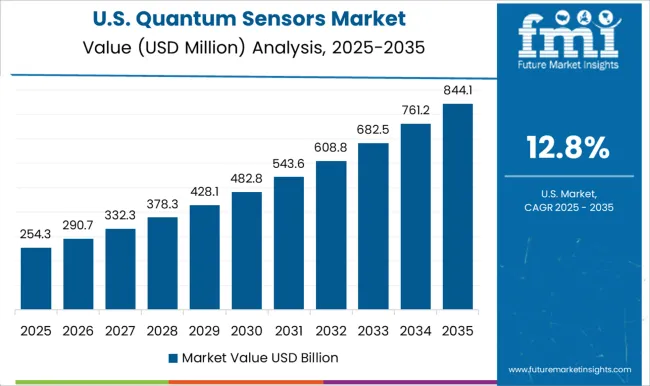
The United States quantum sensors market is forecast to grow at a CAGR of 12.8% from 2025 to 2035, driven by defense applications, satellite navigation, and precision metrology. Federal agencies and private enterprises are collaborating to commercialize atomic clocks, magnetometers, and accelerometers. The aerospace and autonomous vehicle sectors are leveraging these sensors for ultra-precise positioning. Research in cryogenic and photonic quantum technologies is enhancing device sensitivity and reliability. Early adoption in industrial automation and geophysical monitoring is strengthening the market landscape.
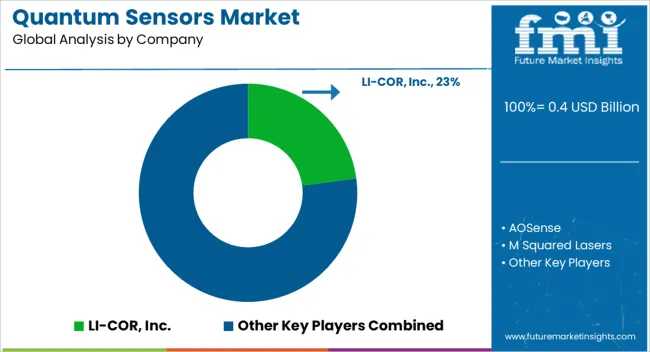
LI-COR, Inc. holds a leading position in the global quantum sensors market, accounting for 23% of the total value in 2025 (equivalent to 0.4 USD billion). The remaining share, 77%, is distributed among other key players such as AOSense, M Squared Lasers, and a wide group of smaller competitors. This indicates that while LI-COR has established a strong foothold with its precision environmental and gas sensing instruments, the market overall remains fragmented, with several companies contributing to the remaining majority share.
ID Quantique specializes in quantum cryptography and photonic sensing, enhancing security and measurement fidelity in communications and defense applications. Campbell Scientific Inc. integrates quantum sensing modules with data acquisition systems, targeting environmental and geophysical monitoring sectors. Atomionics focuses on atomic interferometry and cold atom technologies, enabling highly precise gravimetry and magnetic field detection.
| Item | Value |
|---|---|
| Quantitative Units | USD Billion |
| Type | Atomic clocks, Magnetometers, Gravimeters, Gyroscopes, Acoustic sensors, Interferometers, and Quantum imaging |
| Platform | Neutral atoms, Photons, Trapped ions, Nuclear magnetic resonance, and Optomechanics |
| End Use | Aerospace & defense, Agriculture & environment, Oil & gas, Transportation, Healthcare, Automation, Construction, and Others |
| Application | Precision measurement, Environmental monitoring, Medical imaging, and LiDAR |
| Regions Covered | North America, Europe, Asia-Pacific, Latin America, Middle East & Africa |
| Country Covered | United States, Canada, Germany, France, United Kingdom, China, Japan, India, Brazil, South Africa |
| Key Companies Profiled | LI-COR, Inc., AOSense, M Squared Lasers, ID Quantique, Campbell Scientific Inc., Atomionics, and Apogee Instruments |
| Additional Attributes | Dollar sales by sensor type and application segment, demand dynamics across healthcare, defense, navigation, and industrial monitoring, regional trends in adoption across North America, Europe, and Asia-Pacific, innovation in ultra-sensitive measurement technologies, compact design, and quantum interference techniques, environmental impact of manufacturing processes and device lifecycle, and emerging use cases in precision navigation, magnetic field mapping, and advanced medical diagnostics. |
The global quantum sensors market is estimated to be valued at USD 0.4 billion in 2025.
The market size for the quantum sensors market is projected to reach USD 1.7 billion by 2035.
The quantum sensors market is expected to grow at a 15.0% CAGR between 2025 and 2035.
The key product types in quantum sensors market are atomic clocks, magnetometers, gravimeters, gyroscopes, acoustic sensors, interferometers and quantum imaging.
In terms of platform, neutral atoms segment to command 28.6% share in the quantum sensors market in 2025.






Our Research Products

The "Full Research Suite" delivers actionable market intel, deep dives on markets or technologies, so clients act faster, cut risk, and unlock growth.

The Leaderboard benchmarks and ranks top vendors, classifying them as Established Leaders, Leading Challengers, or Disruptors & Challengers.

Locates where complements amplify value and substitutes erode it, forecasting net impact by horizon

We deliver granular, decision-grade intel: market sizing, 5-year forecasts, pricing, adoption, usage, revenue, and operational KPIs—plus competitor tracking, regulation, and value chains—across 60 countries broadly.

Spot the shifts before they hit your P&L. We track inflection points, adoption curves, pricing moves, and ecosystem plays to show where demand is heading, why it is changing, and what to do next across high-growth markets and disruptive tech

Real-time reads of user behavior. We track shifting priorities, perceptions of today’s and next-gen services, and provider experience, then pace how fast tech moves from trial to adoption, blending buyer, consumer, and channel inputs with social signals (#WhySwitch, #UX).

Partner with our analyst team to build a custom report designed around your business priorities. From analysing market trends to assessing competitors or crafting bespoke datasets, we tailor insights to your needs.
Supplier Intelligence
Discovery & Profiling
Capacity & Footprint
Performance & Risk
Compliance & Governance
Commercial Readiness
Who Supplies Whom
Scorecards & Shortlists
Playbooks & Docs
Category Intelligence
Definition & Scope
Demand & Use Cases
Cost Drivers
Market Structure
Supply Chain Map
Trade & Policy
Operating Norms
Deliverables
Buyer Intelligence
Account Basics
Spend & Scope
Procurement Model
Vendor Requirements
Terms & Policies
Entry Strategy
Pain Points & Triggers
Outputs
Pricing Analysis
Benchmarks
Trends
Should-Cost
Indexation
Landed Cost
Commercial Terms
Deliverables
Brand Analysis
Positioning & Value Prop
Share & Presence
Customer Evidence
Go-to-Market
Digital & Reputation
Compliance & Trust
KPIs & Gaps
Outputs
Full Research Suite comprises of:
Market outlook & trends analysis
Interviews & case studies
Strategic recommendations
Vendor profiles & capabilities analysis
5-year forecasts
8 regions and 60+ country-level data splits
Market segment data splits
12 months of continuous data updates
DELIVERED AS:
PDF EXCEL ONLINE
Quantum Photonics Market Size and Share Forecast Outlook 2025 to 2035
Quantum Detector Market Size and Share Forecast Outlook 2025 to 2035
Quantum Cascade Laser Market Size and Share Forecast Outlook 2025 to 2035
Quantum Imaging Devices Market Analysis - Size, Share, and Forecast Outlook 2025 to 2035
Quantum Cascade Lasers Market Growth - Trends & Forecast 2025 to 2035
Quantum Computing Market Growth – Trends & Forecast 2025 to 2035
Quantum Cryptography Market Insights - Growth & Forecast 2025 to 2035
Sensors Market Analysis by Type, Technology, End User & Region - Forecast from 2025 to 2035
Quantum Dot Market Analysis by Application, End-Use Industry, Material Type, Technology, and Region Through 2035
Biosensors Market Trends – Growth & Future Outlook 2025 to 2035
UV Sensors Market Analysis by Type, End User, and Region from 2025 to 2035
Nanosensors Market Size and Share Forecast Outlook 2025 to 2035
VOC Sensors and Monitors Market Analysis - Size, Growth, and Forecast 2025 to 2035
Rain Sensors Market Size and Share Forecast Outlook 2025 to 2035
Post-Quantum Cryptography (PQC) Migration Market Analysis - Size, Share, and Forecast Outlook 2025 to 2035
Skin Sensors Market Size, Growth, and Forecast for 2025 to 2035
Weft Sensors Market - Size, Share, and Forecast Outlook 2025 to 2035
ADAS Sensors Market Growth - Trends & Forecast 2025 to 2035
PM2.5 Sensors for Home Appliances Market Size and Share Forecast Outlook 2025 to 2035
Image Sensors Market Growth – Trends & Forecast through 2034

Thank you!
You will receive an email from our Business Development Manager. Please be sure to check your SPAM/JUNK folder too.
Chat With
MaRIA